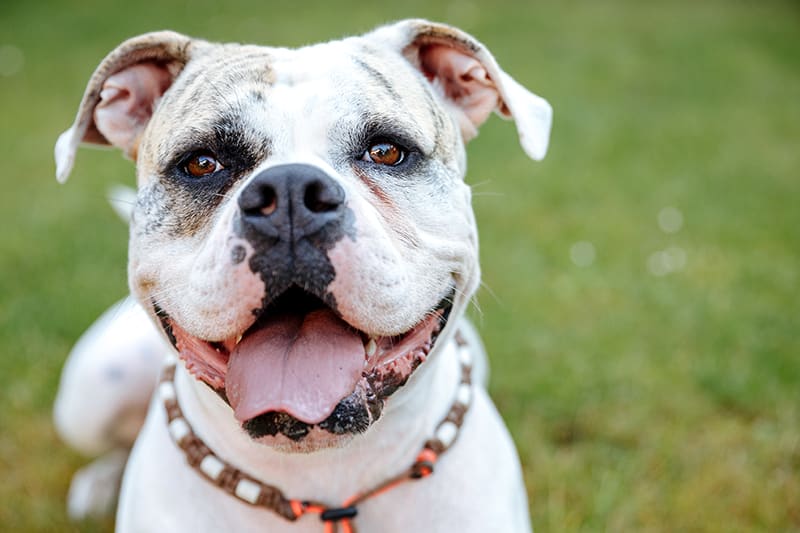Finding a Lump on Your Dog
If you have found a lump or discolored patch of skin on your dog you're bound to begin worrying about cancer. That said, it's important for pet parents to remember that not all lumps and bumps are cancerous, and for those that are cancerous many are treatable when detected early. If you have found something suspicious on your dog take your pup to the vet for a full examination as soon as possible.
3 Types of Skin Cancer Seen in Dogs
Squamous Cell Carcinoma
Skin squamous cell carcinoma is the most commonly diagnosed form of skin cancer in dogs and typically seen in older animals. These tumors appear as raised wart-like patches or lumps that are firm to the touch and typically located on the dog's head, lower legs, rear, and abdomen. Exposure to the sun may be a cause of squamous cell carcinoma, however, there could also be a link to papillomavirus. This form of cancer is frequently seen in white Bull Terriers, Dalmatians, Beagles, and Whippets.
Malignant Melanoma
Melanomas are raised bumps that are often (but not always) dark-pigmented and frequently found around the dog's lips, mouth and nail bed. While most melanomas are benign they can be malignant. Malignant melanomas are a very serious threat to your dog's health. These tumors grow quickly and have a high risk of spreading to other organs. Male dogs are more at risk of melanomas than females and certain breeds such as Schnauzers and Scottish Terriers also face an increased risk.
Mast Cell Tumors
Mast cell tumors are another type of cancer commonly diagnosed in our canine companions. This cancer occurs in the mast cells of the dog's immune system. Mast cell tumors can grow anywhere on your pup’s skin, including internal organs however, some of the most common sites for mast cell tumors are on the limbs, lower abdomen, and chest. This form of skin cancer is most often diagnosed in dogs between ages 8 -10 years old. Some of the breeds facing an increased risk of developing this disease include: Boxers, Pugs, Rhodesian Ridgebacks, and Boston Terriers.
Diagnosing Dog Skin Cancers
To diagnose skin cancer in dogs, your vet may perform a fine needle aspiration in order to take a small sample of the tumor's cells to examine or perform a biopsy in order to take a portion of the tumor's tissue for examination. These samples will be sent to a lab to be analyzed, in order for your vet to provide you with an accurate diagnosis of your dog's condition. To determine the extent of cancer in the body after the initial diagnosis, additional diagnostic testing can help to optimize treatment recommendations and more accurately predict prognosis.
Treatment for Skin Cancers in Dogs
Often dogs that are diagnosed with skin cancers in the early stages can be treated successfully and go on to live full active lives.
Cancer can be treated with several different therapies or treatment combinations, including surgery, chemotherapy, immunotherapy, targeted therapies or palliative care when appropriate. When it comes to the prognosis and treatment for cancer in dogs, options will depend on a number of factors, such as the type of tumor, the tumor's location, how advanced the cancer is.
At Animal Hospital of Clemmons, our team of veterinarians is dedicated to providing the best care and treatment to sick pets, including dogs diagnosed with skin cancer.
Monitoring Your Dog's Health
Spotting the signs of skin cancer while the disease is still in the early stages is the key to good treatment outcomes. Familiarizing yourself with all your dog’s lumps, bumps, and rashes, during your regular grooming routine, as well as visiting your vet for routine wellness exams can help to catch skin cancers in the early stages.
If you notice an unexplained or unusual lump or bump on your dog, or if you notice swelling around your dog's toes consult your veterinarian as soon as possible. When it comes to your pet's health it's always better to err on the side of caution.
Note: The advice provided in this post is intended for informational purposes and does not constitute medical advice regarding pets. For an accurate diagnosis of your pet's condition, please make an appointment with your vet.If you discover a concerning lump or discolored patch of skin on your dog contact Animal Hospital of Clemmons right away to book an examination for your canine companion. Our veterinarians have experience diagnosing and treating cancer in dogs and cats.
Looking for a vet in
Clemmons?
We're always accepting new patients, so contact our veterinary hospital today to book your pet's first appointment.
Related Articles View All
Grooming Anxiety in Dogs - Tips to Calm Your Anxious Dog
Does your dog become anxious and scared when it comes to grooming time? Here, you will find helpful tips to soothe your dog's nerves and make a trip to the groomer a happy adventure.
Checklist for a Successful First Vet Visit for Your Puppy
It's your puppy's first vet visit. What do you need to bring? What happens at a puppy appointment? Today, we provide tips to help make your puppy's first vet visit successful.
What to Do About Diarrhea in Dogs
Dog diarrhea is a messy problem most pet parents find themselves dealing with at some point. So, what causes diarrhea in dogs and how can you stop it? Read on to find out.
My dog's ear is bleeding! Why? What should I do?
In today's post, you will learn about some common causes of bleeding ears in dogs, other symptoms that may occur along with ear bleeding and when a visit to the vet is required.
Caring for a Dog With a Broken Jaw
You may be surprised to learn that broken jaws are alarmingly common in dogs. Here, you will learn about the causes of a broken jaw in dogs, how they can be repaired, and advice on caring for your pup as their jaw heals.

